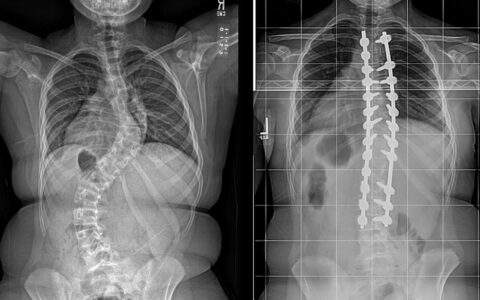Opioid prescriptions can play a critical role in managing pain after surgery, but there’s often variability in when they’re prescribed and at what dosage.
“Standard prescribing protocols are critical because for every additional day’s worth of unused opioid prescriptions, the risk of opioid misuse increases by 10 percent in the pediatric population,” said Jeffrey Martus, M.D., an associate professor of orthopaedic surgery and rehabilitation at Monroe Carell Jr. Children’s Hospital at Vanderbilt.
To assess the impact of implementing a standard opioid prescribing protocol after pediatric orthopaedic surgery, Martus and colleagues including Kirsten Ross, M.D., administrative chief resident in the Department of Orthopaedic Surgery at Vanderbilt University Medical Center, completed a prospective study of over 1,600 pediatric patient records.
“Since we know that overprescription of opioids is a key contributor to the opioid epidemic,” Ross said, “we recognized the need for this protocol to decrease the variability in prescribing practices and therefore decrease the supply of leftover opioids out in the community.”
“For every additional day’s worth of unused opioid prescriptions, the risk of opioid misuse increases by 10 percent in the pediatric population.”
Implementation of Standard Dosing Protocol
Martus, Ross and colleagues began by examining their division’s opioid prescribing practices. They realized prescribing varied between providers, even for similar procedures, and that little research existed regarding the amount of opioids patients used after different surgeries.
For their quality improvement study, the team developed a prescribing protocol based on surgery severity. For example, a buckle fracture in a patient younger than 18 months fell into the minimal dosage category of zero doses, while a shoulder arthroscopy fell into the intermediate dosage category of 42 doses.
The research team collected baseline data in October 2017 and started testing the protocol in November 2017, measuring the percentage of pediatric patients correctly dosed according to the protocol each week. The team also measured the average number of opioids prescribed at discharge each week for all pediatric orthopaedic surgery patients between October 2017 and September 2018.
“Our goal was to have more than 90 percent of prescriptions compliant with the protocol,” Ross said.
After reviewing 1,645 patient records throughout the study, the team found that adherence to the prescribing protocol had increased from zero to 97 percent for all types of pediatric surgery. In addition, the mean prescribed opioid doses following surgery decreased from 21.9 to 17.8 doses.
For every additional day’s worth of unused opioid prescriptions, the risk of opioid misuse increases by 10 percent in the pediatric population,”
Ensuring Protocol Success
Ross said health systems can put several processes in place to ensure more adherence to prescribing protocols once they are developed.
“Having prescribers actively involved early in the protocol development can certainly help with buy-in,” she said. “I think the best thing health systems and departments can do is to have a system in place to track and frequently analyze compliance and give prescribers feedback.”
Ross added that the team analyzed data monthly and found compliance was lower on the weekends when residents who were taking weekend calls — and not on their regular pediatric orthopaedic rotations — were writing the prescriptions. Capturing this insight and sharing it with residents helped to improve compliance.
“We have found most prescribers are very open to the feedback and the opportunity to decrease their opioid prescriptions,” Ross said.
Setting Patient Expectations
A standard prescribing protocol also benefits patients, helping to properly set their expectations and engaging them in their own care. Ross said she and her colleagues have found that when patients know what to expect after surgery, they rarely feel like they need more than their prescribed dosage.
“It’s the responsibility of all healthcare providers to educate themselves on safe prescribing practices,” Ross said. “The goal should be to minimize leftover opioid medication, and we have shown that a standardized protocol is a good way to start working towards this goal.”







